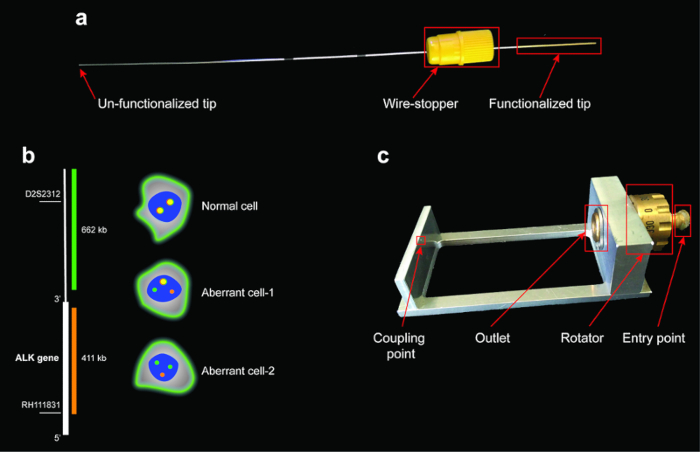Se requiere una suscripción a JoVE para ver este contenido. Inicie sesión o comience su prueba gratuita.
3D DNA FISH: A Technique to Locate a Specific Gene on a Chromosome
En este artículo
Overview
Circulating tumor cells (CTC) isolation and characterization from the blood of cancer patients is a type of non-invasive liquid biopsy and associated with relapse and disease progression. This video describes the technique of DNA fluorescence-in-situ-hybridization (DNA FISH) on CTCs captured on a medical wire, to study a specific gene of interest.
Protocolo
1. 3D DNA-FISH Day 2
CAUTION: Special attention must be paid to the high temperature of the instruments and humid chamber.
- Set up the hybridization oven and dry heat oven (~ 3 h before starting the DNA-FISH protocol). Set the hybridization oven at 75 °C, set the dry heat oven at 37 °C, and cool the 0.4× SSC solution (pH = 7.0 ± 0.1) to 4 °C.
NOTE: The pH status of FISH buffers is critical and must be 7.0 ± 0.1. - Wash the wire 3 times in ice-cold 0.4× SSC solution.
NOTE: Keep the wire in the dark to avoid fluorochrome photobleaching during the following procedures. - Dry for 10 min in the dark under the fume cupboard.
- Vortex and spin the probe for 5 s.
- Drop 10 µL of the probe into the glass microtubes. Cover with laboratory film.
- Spin the microtubes as follows: wrap the microtube in a dry absorbent, paper put into a 50-mL tube, and spin briefly.
- Carefully place the dried wire into the microtube and insert the wire-stopper. Seal with rubber cement.
CAUTION: The next two steps involve high temperatures. Wear protective gloves. - Put the wire into a dark humid chamber in the hybridization oven for 8 min at 75 °C to obtain complete DNA denaturation.
- Move the humid chamber into a dry heat oven at 37 °C overnight.
2. 3D DNA-FISH Day 3
- Put a slide staining jar with 0.4× SSC solution into a water bath and set at 72 °C.
- Check the 0.4× SSC solution temperature until it reaches 72 ± 1 °C.
- Prepare two glass beakers, one with 2× SSC + 0.05% Tween (pH = 7.0 ± 0.1) solution and the second one with distilled water.
- Remove the humid chamber from the dry heat oven, carefully remove the rubber cement from the wire-stopper using tweezers, and take out the wire.
NOTE: Carefully pull the uncoated end of the wire through the IN-Stopper, being careful not to damage the functionalized tip. - Dip the wire into the 0.4× SSC solution for 2 min at 72 °C.
- Wash the wire in 2× SSC + 0.05% Tween solution for 30 s at RT.
- Wash the wire in distilled water at RT.
- Dry the wire under the fume hood for 10 min in the dark.
- Prepare a DAPI stock solution of 1.43 µM in 2 mL of 1× PBS.
- Incubate the functionalized tip of the wire with DAPI solution in a 2 mL vial for 1 h in the dark at RT.
- Rinse the wire twice in 1× PBS and air-dry.
3. 3D microscope observation and analysis
- Position the wire in the wire holder. Carefully insert the functionalized tip through the entry point of the special holder, until the tip matches the coupling point. Be careful not to damage the functionalized tip (Figure 1a).
- Place the special holder on the microscope stage. Adjust the focus of the microscope using a 20× lens. First coarsely focus on the special support and then adjust finely on cells that appear bright in the DAPI-channel.
Resultados

Figure 1: Functionalized wire, schematic arrangement of ALK break-apart probes, scheme of expected patterns of ALK rearrangement, and special holder. (a) Red boxes highlight the three main parts of the wire: functionalized tip, wire-stopper, and un-functionalized tip. The functionalized tip is the most delicate part of the wire and must not be touched ...
Divulgaciones
Materiales
| Name | Company | Catalog Number | Comments |
| Tween 20 | BIO RAD | # 1706531 | |
| Vysis 20X SSC (66g) | Abbott Molecular Inc. | # 30-804850 | powder to be resuspended in distilled water, as recommended |
| Water | MilliPore | ||
| DAPI, FluoroPure grade | Invitrogen | # D21490 | |
| ZEISS Fluorescent Microscope Axioskop | ZEISS |
Referencias
This article has been published
Video Coming Soon
Source: Gallerani, G. et.al. Characterization of Tumor Cells Using a Medical Wire for Capturing Circulating Tumor Cells: A 3D Approach Based on Immunofluorescence and DNA FISH. J. Vis. Exp. (2017).
ACERCA DE JoVE
Copyright © 2025 MyJoVE Corporation. Todos los derechos reservados